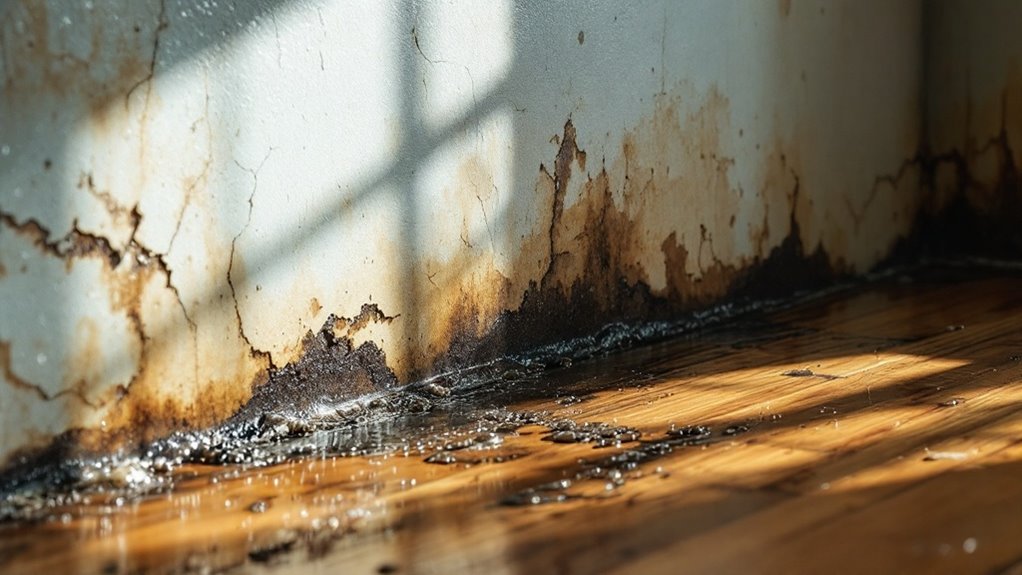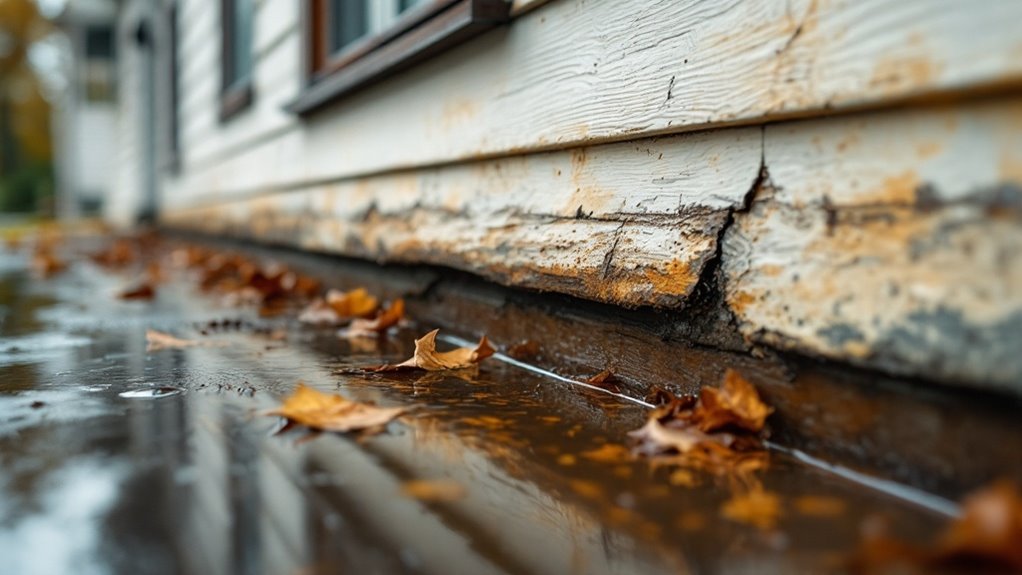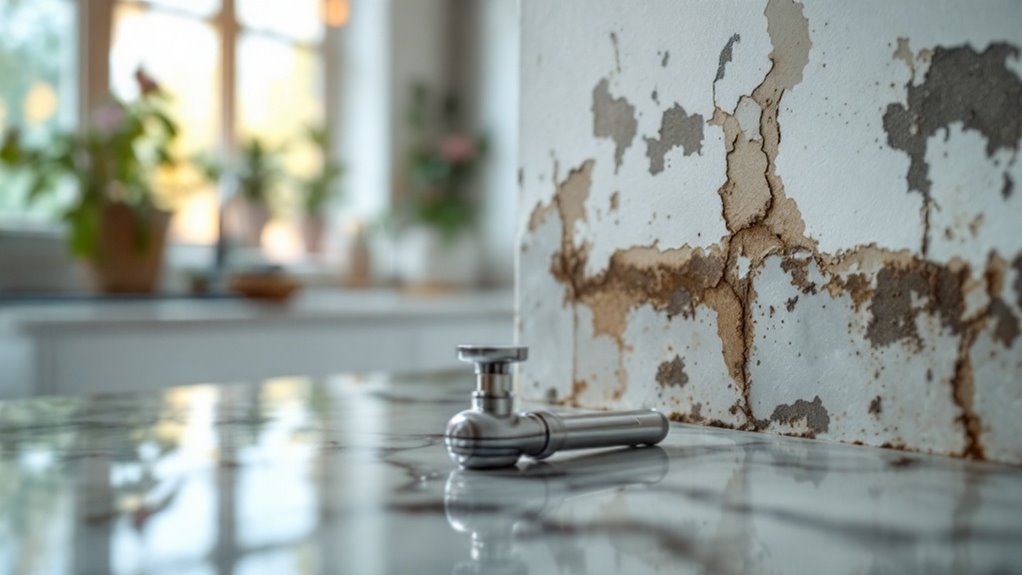You might think water damage is something that only happens in old homes, but that’s simply not true. Even new constructions can face this issue if you’re not vigilant. Knowing how to spot the signs early can save you from costly repairs down the line. From hidden leaks to visible mold, there are several indicators you should be aware of. Let’s investigate how you can protect your home before it’s too late.
Key Takeaways
- Regularly inspect for water stains on ceilings, walls, and floors, as they indicate potential leaks or moisture issues.
- Check for dampness or moldy smells in enclosed spaces, which can signal hidden water damage.
- Look for peeling paint or wallpaper, as it suggests moisture buildup beneath the surface.
- Monitor your home’s exterior for missing shingles, cracks in siding, and improper drainage that could lead to water intrusion.
- Conduct routine plumbing inspections to catch leaks and clogs early before they escalate into major problems.
Understanding the Causes of Water Damage

While you may not always notice it, water damage can stem from various sources, and understanding these causes is crucial for prevention. Leaky pipes and fixtures are common culprits, often unnoticed until it’s too late. Roof leaks, because of age or storm damage, can likewise lead to significant issues. Poor drainage systems around your home can trap water, causing it to seep into walls and foundations. Moreover, humidity and condensation can create problems, especially in poorly ventilated areas like basements and attics. Even appliances like washing machines and refrigerators can contribute to water damage if they’re not maintained. By recognizing these sources, you can take proactive steps to protect your home from potential water damage. Regular roof maintenance can significantly reduce the risk of leaks and subsequent damage.
Common Signs of Water Damage to Look For
If you suspect your home has suffered water damage, it’s essential to know the common signs to look for. First, check for water stains on ceilings, walls, or floors. These often appear as yellowish or brownish patches. Next, feel for dampness or moldy smells, which can indicate hidden moisture. Peeling paint or wallpaper is another red flag, as it suggests water is getting underneath. Moreover, pay attention to warped or buckled floors; this can signal long-term exposure to water. Finally, inspect your home for any visible mold growth, particularly in dark, damp areas. By keeping an eye out for these signs, you can catch water damage early and take action before it worsens. Additionally, it’s crucial to understand that water mitigation techniques can help minimize further damage once water intrusion is detected.
Inspecting Your Home’s Exterior

Inspecting your home’s exterior is crucial for identifying potential water damage before it becomes a serious issue. Start by examining your roof for missing shingles or signs of wear. Look for any sagging areas, as they can indicate trapped water. Next, check gutters and downspouts to confirm they’re clear and directing water away from your foundation. Pay attention to siding for cracks or gaps that could allow moisture in. Don’t forget to inspect doors and windows; make certain seals are tight and frames are intact. Finally, observe the grading around your home. It should slope away from the foundation to prevent water pooling. Regular inspections can help you catch problems early and save you from costly repairs. Additionally, be aware of unexplained water stains that may reveal underlying issues before they escalate.
Checking for Water Damage in the Basement
When checking for water damage in your basement, start by inspecting for mold growth, as it often indicates moisture issues. Next, look for water stains on the walls or floor, which can reveal past or present leaks. Finally, monitor humidity levels; high humidity can lead to further water damage if left unchecked.
Inspect for Mold Growth
How can you tell if mold is lurking in your basement? Start by looking for any suspicious dark spots on walls, ceilings, or floors. Mold often appears as black, green, or white patches, and it thrives in damp areas. Pay attention to any musty odors; they’re a strong indicator of mold growth. Don’t forget to check behind furniture or appliances, as mold can hide in less visible places. If you notice any condensation or excessive humidity, it’s a sign that mold could develop. Ascertain proper ventilation in your basement to reduce moisture levels. By being vigilant and proactive, you can catch mold early and prevent it from spreading, keeping your basement safe and healthy.
Look for Water Stains
Water stains are a clear warning sign of potential damage in your basement. When you spot these stains, it’s essential to take them seriously. Look for discoloration on walls, ceilings, and floors; they often appear as yellowish or brown patches. These stains can indicate leaks from plumbing issues or water seeping in from outside. Don’t ignore them, as they can lead to mold growth and structural damage if left unchecked. Pay attention to the size and location of the stains, as larger or spreading stains may signal more serious problems. Regularly inspect your basement for these signs, and if you find them, act quickly to address the underlying issue before it escalates.
Check Humidity Levels
Have you ever considered how humidity levels can indicate water damage in your basement? High humidity is often a sign that moisture is lurking, which can lead to mold growth and structural issues. To check humidity levels, grab a hygrometer—these devices are affordable and easy to use. Ideally, your basement’s humidity should stay between 30% and 50%. If it exceeds this range, take action immediately. Start by ventilating the area, using dehumidifiers if necessary, and checking for leaks or cracks in walls. Regularly monitoring humidity not only helps you spot potential water damage early but likewise keeps your basement a healthier space. Don’t ignore those levels; they can save you from costly repairs down the line.
Signs of Water Damage in Ceilings and Walls
While you might not think about your ceilings and walls often, they can reveal important signs of water damage. Look for discoloration, such as yellow or brown spots, which often indicate moisture buildup. Peeling or bubbling paint and wallpaper can likewise signal trouble beneath the surface. If you notice warped or sagging areas, that’s a clear sign of water intrusion. Furthermore, check for mold or mildew growth, as these thrive in damp conditions. Listen for unusual sounds, like dripping or running water, which could suggest a leak. By keeping an eye on these signs, you can catch potential problems early and take action before water damage worsens, saving you time and money in the long run.
The Importance of Regular Plumbing Inspections

Regular plumbing inspections are essential for keeping your home safe from water damage. By catching issues early, you can save money and avoid bigger problems down the line. You’ll additionally benefit from preventative maintenance that keeps your plumbing system running smoothly.
Preventative Maintenance Benefits
To keep your home safe from water damage, it’s crucial to prioritize preventative maintenance through regular plumbing inspections. By doing so, you can identify potential issues before they escalate, saving you time and money in the long run. Regular inspections help guarantee your plumbing system operates efficiently and can greatly reduce the risk of unexpected leaks or breaks.
Here are some key benefits of regular plumbing inspections:
- Early Problem Detection: Catch leaks and clogs before they become serious.
- Cost Savings: Prevent costly repairs and water bills associated with water damage.
- Peace of Mind: Know your plumbing is in good condition and reduce stress over potential issues.
Investing in preventative maintenance is a smart choice for any homeowner.
Early Detection Techniques
How can you guarantee your home stays protected from water damage? One of the most effective ways is through regular plumbing inspections. By scheduling these inspections, you catch potential issues before they escalate. A professional plumber can identify faulty pipes, leaks, or signs of water buildup that you might overlook. You should likewise familiarize yourself with common warning signs: damp spots, mold growth, and unusual water bills can indicate underlying problems. Make it a habit to inspect areas like under sinks and around appliances. If you notice any irregularities, address them promptly. Taking these proactive steps guarantees you maintain a safe, dry environment, ultimately safeguarding your home from costly water damage repairs in the future.
Cost-Effective Solutions
Scheduling plumbing inspections not only helps you spot potential issues early but likewise proves to be a cost-effective solution for maintaining your home. Regular inspections can save you money in the long run by preventing more extensive damage and costly repairs. By catching minor leaks and clogs before they escalate, you protect your investment and peace of mind.
Consider these benefits of routine plumbing inspections:
- Early detection of leaks can prevent mold growth and structural damage.
- Lower repair costs by fixing small issues before they become major problems.
- Increased home value through proper maintenance, making it more appealing to potential buyers.
Investing in regular plumbing checks is a smart way to safeguard your home and wallet.
Identifying Mold and Mildew Growth
Have you noticed a musty smell in your home or seen dark spots on walls and ceilings? These are clear signs of mold and mildew growth, which often thrive in damp conditions. First, check areas prone to moisture, like bathrooms, kitchens, and basements. Look for discoloration or fuzzy patches, which can range in color from black to green. Don’t ignore hidden spots; inspect behind furniture or appliances where water might accumulate. If you find mold, it’s essential to address it quickly, as it can pose health risks. Remember, even a small amount of mold can spread rapidly. If you’re unsure about identification, consider consulting a professional for assistance in evaluating and treating the affected areas.
Monitoring Your Home’s Humidity Levels
Keeping your home’s humidity in check is essential for preventing water damage. Ideally, you want to maintain humidity levels between 30% and 50%. Using humidity monitoring tools can help you easily track these levels and take action when needed.
Ideal Humidity Range
Maintaining the ideal humidity range in your home is crucial for preventing water damage and guaranteeing a healthy indoor environment. Ideally, you want to keep humidity levels between 30% and 50%. When the humidity is too high, it can lead to mold growth and structural damage. Conversely, low humidity can dry out wood, causing cracks and gaps.
To help manage humidity, consider the following:
- Ventilation: Guarantee proper airflow in areas like kitchens and bathrooms.
- Dehumidifiers: Use them in damp areas to reduce moisture.
- Regular Checks: Monitor humidity levels routinely to catch fluctuations early.
Humidity Monitoring Tools
Monitoring your home’s humidity levels is vital for preventing water damage and maintaining a comfortable environment. To effectively track humidity, consider investing in a hygrometer. These handy devices measure the moisture levels in the air, giving you real-time data. You can choose between analog and digital models, but digital ones typically offer more features, like alerts for high humidity levels.
Smart home systems can additionally help by providing integrated humidity monitoring. Some systems send notifications straight to your phone, so you can act quickly if levels rise too high. Regularly checking your home’s humidity helps you stay ahead of potential issues, ensuring a safer and more pleasant living space. Don’t wait for problems to arise—monitor your humidity today!
The Role of Seasonal Changes in Water Damage
As seasons change, the risk of water damage fluctuates, affecting your home in various ways. In spring, melting snow and heavy rains can lead to roof leaks and flooded basements. Summer brings humidity, which can cause condensation and mold growth. In autumn, falling leaves can clog gutters, directing water towards your foundation. Winter’s freezing temperatures can lead to burst pipes if not properly insulated.
To protect your home during these seasonal shifts, keep an eye on:
- Roof condition: Check for missing shingles after storms.
- Gutters: Clean them regularly to prevent overflow.
- Basement: Monitor for dampness, especially after heavy rain.
Staying vigilant during these changes can help you spot potential water damage before it becomes a bigger issue.
Taking Immediate Action: What to Do If You Spot Water Damage
If you notice signs of water damage, acting quickly can make all the difference in preventing further issues. Start by identifying the source of the leak, whether it’s a broken pipe, roof leak, or condensation. Once you’ve found it, shut off the water supply to stop the flow. Next, remove any standing water using a wet/dry vacuum or towels to minimize damage to your floors and walls. Dry the affected area thoroughly with fans or dehumidifiers, and consider removing soaked materials like carpets or drywall. Document the damage with photos for insurance claims. Finally, consult a professional if the damage is extensive or if you’re unsure about the repairs needed. Swift action helps protect your home and peace of mind.
Conclusion
To sum up, staying vigilant about water damage can save you from costly repairs down the line. By regularly inspecting your home and addressing issues promptly, you’re not just protecting your investment; you’re safeguarding your peace of mind. Remember, just as a small leak can sink a mighty ship, neglecting the signs of water damage can lead to significant problems. So, keep your eyes peeled and take action—your home deserves it!
